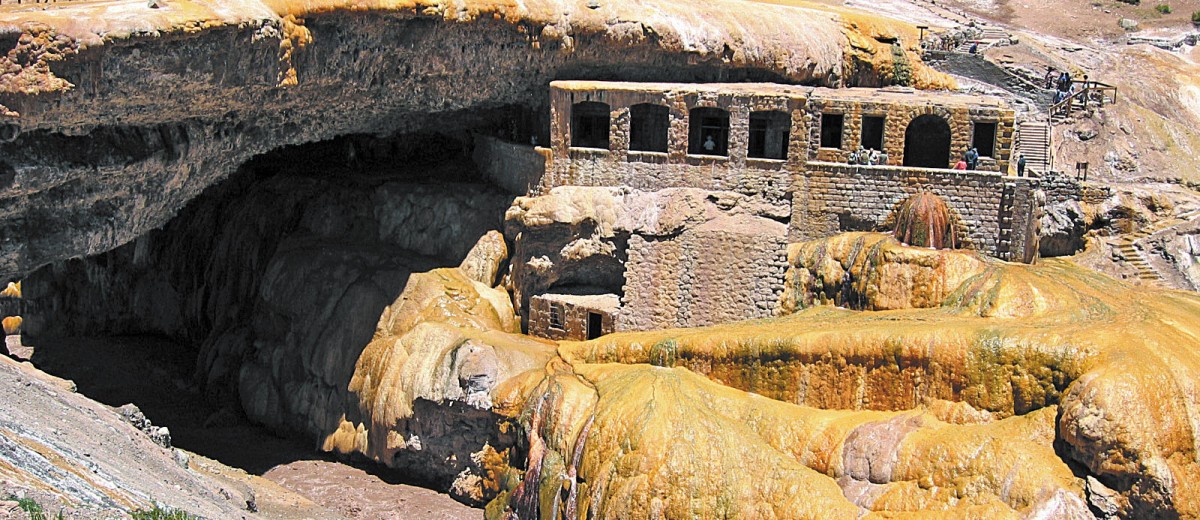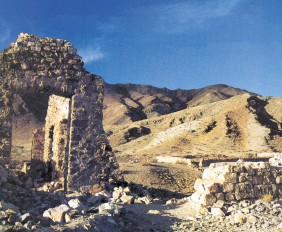The Inca conquest, towards 1480 AD built its roads following these natural traces, not only in this region, but all along the Andes Mountain Range from the south of Colombia to Mendoza and Santiago de Chile, crossing the wildest and most varied landscapes, bridging abyss, crossing swamps, lakes, desserts, high peaks, and dense forests. Twenty-five thousand kilometers of these routes are known and have been studied; and it is estimated that by the time the Spanish arrived its length was of forty thousand kilometers.
In our region it consists of a 2.5 m wide path cleared of stones. It goes from the north of Mendoza, entering the Yalguaraz swamp. It runs south through the high piedmont of Cordón del Tigre, it gets to Tambillos, and then continues a few kilometers south-west to the present territory of Chile. Nowadays, in this last area, the Inca trail intertwines with part of National Route 7. Towards the north of Yalguaraz the Inca trail continues to Calingasta Valley and from there it goes to the Argentinean north-west. With an plateau in between, this Inca trail leads to Cuzco, 2200 km. north of Mendoza.
Qhapaq ñan or Inka ñan was the back bone and main element of the Inca domination. Through it, “chasquis” or messengers run connecting the different ecosystems of Tahuantinsuyu. But it also meant the symbolic presence of power and authority of the Inca Empire, as there existed a hierarchy of people responsible for the maintenance and control of the trail along its thousands of kilometers.
Tambos (Incan structure)
Roads were marked by tambos (tampu), which are Incan constructions used as lodging for the Incas or for travelers under official missions, and also as depositories of food, firewood, clothes, fodder, weapons, and other necessary products for the state control system.
Tambos make up a true net, of which its remains can be seen nowadays, following the road to which they are linked. In Uspallata and the high mountain from north to south these remains are: Ciénaga de Yalguaraz, Tambillos, Ranchillos, Tombillitos, Los Penitentes, and Las Cuevas. Its walls were made of stone, and they had enclosed areas attached to the main or secondary walls that were used as rooms, for storage, as pen, etc. Some were used as fortress, and others were transformed into resorts, as through them thermal water flowed.
High-altitude Sanctuaries
To these remains, each having a different degree of importance according to their level of preservation, we have to add ceremonial sites, and the so-called high-altitude sanctuaries, which also extend along Qhapaq Ñan.
Where a cross-cutting path connected both mountain slopes, a prominent hill was picked for ascensions and sometimes for sacrifice rituals. A good example of this is the burial found in the Aconcagua, where the mummified body of a seven year old kid was found with all the funerary remains, with bundles containing more than twenty textile pieces, gold figurines and mollusk shells.
It is believed that these sanctuaries were probably made at the time the Inca Empire settled in the area of Cuyo and central Chile, about 500 years ago to assure the process of expansion of territory. As human sacrifices took place when an emperor died, the dominance over a new territory was a deed that had to be celebrated, and so, the sacrifice of a pig, which was considered something sacred, took place.
Incas and Huarpes as well, believed Gods lived in the mountains. They believed they had to offer them presents so that the snow for water sources would not dry, so that cattle lived on their slopes, and so hunting was abundant.
In 1897, Fitz Gerald discovered a ceremonial spot on the hill Penitentes. It was a true open temple where Incas carried out their rites of worship.
Currently, the Inca trail is under international scrutiny, as it has been suggested before the UNESCO to become a World Heritage Site. Argentina, Bolivia, Chile, Ecuador and Perú jointly presented this project.
Esta entrada también está disponible en: Spanish Portuguese (Brazil)








¿Qué te pareció la publicación?